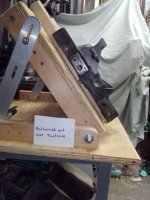Working on saddle and cross slide of SB 10L lathe. It's getting a lot better but is still tighter at the ends of travel than in the center when I assemble it for a test fit.
I have used the Kingway type tool, Foster angled straitedge and various indicator setups on the surface plate. I think part of the problem may be a slightly convex or concave surface someplace. I found I can pivot the cross slide by hanging it off a blued angled straitedge that is held in a vise at a slight angle. I rescraped the part to improve the pattern and get the pivot points closer to the 1/3 points.

Next I move on to the saddle again. I built a tilting table to hold the saddle while scrapeing and to balance the straitedge. This works OK but I cannot do a pivot test because all the weight of the dovetail is pressing into the corner. I can get a reasonable blueing pattern but not sure i trust it.

Next thing I tried was to put the saddle back on on horizontal surface and I added a counter weight to the straightedge. I clamped a dial indicator clamp to the straitedge then added a vise to that as a counterweight. Then I adjusted the vise position so the entire contraption balances on the saddle. This showed me the pivot points were at one end and the middle so I have a little touch up to do. I think I will make a heavier duty clamp for the counterweight.

I am not sure how to best check flatness of the angled surfaces of the saddle. I may try to put the tilting table on the surface plate and adjust the angled surface level so it can be checked with an indicator. I know I need to check the actual angle against the cross slide and need to check spacing on the saddle with the kingway type tool. I also need to check cross slide with gib attached with the Kingway. I have checked alignment on the surface plate to an arbor that replaces the lead screw on the saddle. I found that using a dial indicator on the surface plate seems to work better on a blued surface so I do not waste time investigating scrape marks or areas areas that are too low. I have relieved the vertex of the dovetails with a hacksaw blade. I think I just need to keep going back and forth between these various checks, it does seem to be getting a little better with each iteration. My hat is off to anyone that could make a living doing this kind of work, I have a lot to learn.
I have used the Kingway type tool, Foster angled straitedge and various indicator setups on the surface plate. I think part of the problem may be a slightly convex or concave surface someplace. I found I can pivot the cross slide by hanging it off a blued angled straitedge that is held in a vise at a slight angle. I rescraped the part to improve the pattern and get the pivot points closer to the 1/3 points.

Next I move on to the saddle again. I built a tilting table to hold the saddle while scrapeing and to balance the straitedge. This works OK but I cannot do a pivot test because all the weight of the dovetail is pressing into the corner. I can get a reasonable blueing pattern but not sure i trust it.

Next thing I tried was to put the saddle back on on horizontal surface and I added a counter weight to the straightedge. I clamped a dial indicator clamp to the straitedge then added a vise to that as a counterweight. Then I adjusted the vise position so the entire contraption balances on the saddle. This showed me the pivot points were at one end and the middle so I have a little touch up to do. I think I will make a heavier duty clamp for the counterweight.


I am not sure how to best check flatness of the angled surfaces of the saddle. I may try to put the tilting table on the surface plate and adjust the angled surface level so it can be checked with an indicator. I know I need to check the actual angle against the cross slide and need to check spacing on the saddle with the kingway type tool. I also need to check cross slide with gib attached with the Kingway. I have checked alignment on the surface plate to an arbor that replaces the lead screw on the saddle. I found that using a dial indicator on the surface plate seems to work better on a blued surface so I do not waste time investigating scrape marks or areas areas that are too low. I have relieved the vertex of the dovetails with a hacksaw blade. I think I just need to keep going back and forth between these various checks, it does seem to be getting a little better with each iteration. My hat is off to anyone that could make a living doing this kind of work, I have a lot to learn.

